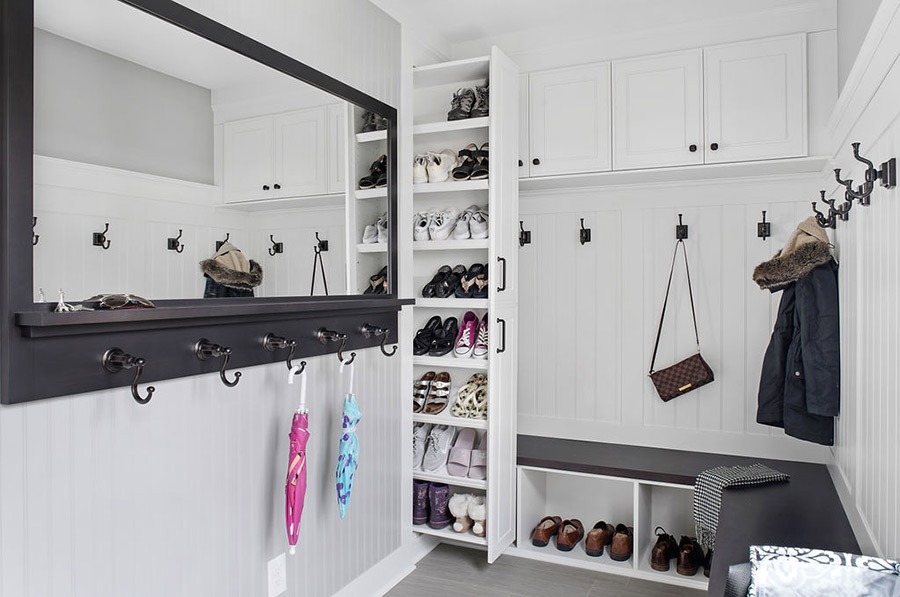Planning a Mudroom Remodel? Busy families need functional storage! Finding places in your home to store coats, sports equipment, backpacks, and more can be challenging, especially if you live in an older home, where a mudroom may be non-existent. Creating a well-equipped organized space or drop zone is a great addition to any home. Mudrooms are typically top on wish lists for Our Clients at The Cleary Company Remodel Design Build Columbus OH and our designers specialize in creating functional award-winning designs that meet the needs of your family.
It doesn’t matter how big or small it is, just that it fits your family’s lifestyle. A functional mudroom’s purpose is to provide an intermediate space that creates a transition between outside and inside. This structured place in your home provides quick and easy storage of items you need when leaving that is easily accessible – especially when leaving home in a rush. So, what do you need to think about if you want a mudroom?
Tips from Designer Olivia Kern Meadows
Olivia Kern Meadows, answers the most common questions our clients ask about mudrooms or, as we like to call them, drop zones. “Storage, in general, is the biggest request from our clients! Everyone is looking for a way to store things in an organized fashion. Once you show someone the best way to optimize their space for storage, you can begin playing around with what types of storage they want and whether it’s open or closed. People also request benches with storage. So, a place to sit and take off and put on their shoes, but also incorporates shoe storage beneath the bench.”
What are the best solutions to hiding or organizing clutter?
Baskets are amazing! Baskets are a great way to hide clutter, especially items that tend to look cluttered even when they are organized, such as keys, chargers, hats, gloves, and scarves. A great way to organize clutter with built-ins is to use several different types of storage: cubbies for basket storage, shoe shelves for shoes to lay flat on, boot storage behind a cabinet door or on a pullout shelf, drawers with dividers for smaller miscellaneous item, and closed storage above a drop zone for additional “messy looking” items.
What do we do with the kids’ shoes, their coats, car keys, winter boots, and pet supplies?
Kids Shoes: Use baskets and shelving situated just high enough that pairs of shoes must go in side-by-side – this forces organization and visual appeal. (Just be sure they are dry.)
Coats: Hooks at various heights allow adults and children to hang more items in a single vertical space. For example, kids hang their items on the lower hooks, while adults can hang their items on the higher hooks. As kids grow, they can begin hanging backpacks on the lower hooks and their coats on the higher hooks.
Car Keys: Install small hooks on the wall by the drawer, place a decorative bowl in the “drop zone”, or keep in a drawer that has organized dividers.
Winter Boots: Cubbies/Dividers at the floor level that go straight down to the actual flooring material are great for maintaining clean cabinetry when storing winter boots. Having adjustable height shelving (especially under a bench) is very helpful when trying to accommodate shoes of all heights and styles. We’ve also done a boot stage on a pullout shelf underneath a drop zone counter.
Pet Food/Supplies: A closed cabinet is the best way to store these items. Typically, under and above the drop zone is a great place because it’s easily accessible, but out of the way. The closed cabinetry not only helps to keep unorganized pet supplies from being visible, but it also helps to keep pet food smells from creeping out into your living space.
What gets overlooked that clients need?
All mudrooms should have charging ports and seasonal storage.
Outlet locations are more important than people realize and placing them strategically within a mudroom/drop zone can really make a difference in how functional the space and outlet can be. Placing outlets with thought will elevate the functionality of that space.
Something that people forget often is that there are other seasons than the one they’re currently in while designing their space. It’s important to create storage within the mudroom that allows clients to rotate their “wardrobe”. For example, when it’s winter, where will you store your scarves, hats, and gloves so that they are easily accessible each day? In the summer, where will you store your scarves, hats, and gloves so that they are out of the way? What about seasonal jackets? It’s not only important to have storage for what you need at the particular time, but it’s also important to have hidden storage for things you don’t need right now.
What’s your favorite mudroom that you designed?
A recent project in Upper Arlington comes to mind. This project has a tall pull-out with shoe storage, a charge station and a deep drawer that pulls out of a base cabinet for boot storage.

Tips from Ryan Schaad from Schaad & Sons Custom Cabinetry
What’s most important? The choice of wood that is used for cabinets. Ryan Schaad, owner of Schaad & Sons, Inc., is one of our premier custom cabinetmakers. We asked him some questions to help you understand the cabinet planning process for your mudroom.
- Best wood species for custom cabinets- maple hardwood. Painted cabinets are very popular and maple allows paint to look like porcelain when it dries. Maple is also the best choice for stained cabinets since the wood can be stained to look like many different wood species.
- We prefer stained over painted because of the wood top surfaces used in the mudroom where you might put your feet or any other objects that might be wet. These spots get the most wear and tear and it is easier to touch up a stained surface, rather than a painted surface.
- Mudroom location can help determine the best type of cabinets for the space. A side entrance used only by the family means a mudroom can have open cubbies and shelves, with hooks for coats and bags. A mudroom that will be exposed to guests might be better with drawers and doors, where everything is hidden away and can be kept cleaner and neater.
- Another feature that looks good and is very practical, leave the floor exposed underneath the bench seat or cubby area. Install the flooring underneath a bench so that you aren’t putting shoes on the wooden base of the cabinet or cubby. This way, when you take off your wet shoes, you aren’t placing them on wooden cabinet surfaces that can break down over time with repeated exposure to melting snow & ice.
- Maintaining solid wood cabinets is easy. Treat them just like you would any other cabinets or piece of wood furniture in your home. You can find cleaning recommendations on the Schaad & Sons website.
If you’re planning a remodel, don’t forget about that drop zone! You know you need it and we’re here to build it for you. Contact our Client Relations Coordinator to get started 614-459-4000 or visit our website.
For more design inspiration visit our pro Houzz profile!
